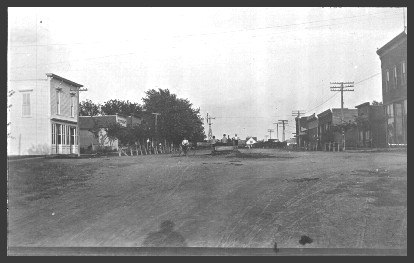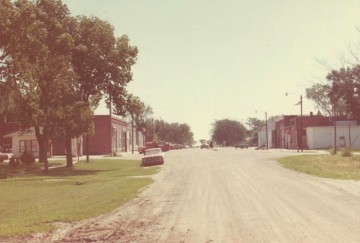
Hamilton County NEGenWeb Project




In the spring of 1880, the Burlington and Missouri River Railroad extended its lines of road from Aurora to Central City, providing the incentive for another town along its route in the county. At the time the railroad was completed there was a post office located on the east half of the northwest quarter of section 21, town 12, range 6, on the section line between sections 16 and 21. This post office was called Avon, and operated by Mrs. Nancy Carnahan. For the first six months the trains just stopped and threw off the mail as they had been unable to acquire land for the purpose. After that a station was opened, which for a year consisted of a handcar house, with O.H. Wirsig as agent. He was soon after appointed postmaster. Early in 1882, the Lincoln Land Company secured from J. W. Marquis, 100 acres of land on the southwest quarter of section 16, town 12, range 6, and surveyed and platted the town of Marquette. The railroad shortly removed an old depot from Dorchester to Marquette and it remained as a landmark for many years. The main street of Marquette was named Marquis Avenue, as Mr. Marquis was the former owner. Thomas Marquette was the attorney for the Land Company so he was honored with the town bearing his name. The village of Marquette was incorporated March 2, 1889, with the first board of trustees including Dr. T.H. Line; M.E. Farr, cashier of the Bank of Marquette; H.D. Hall, hardware and furniture merchant. Mr. Hall was later a county commissioner at the time the present courthouse was built. The first store in Marquette was a general store, and on main street, after its move, was operated by Fairchild & Deal. The drug store operated by R.K. Hughes, was later sold to J.J. Luff, who operated it continuously until his death. He was the oldest druggist in Nebraska. H.D. Hall and S.P. Boyd had a general store. O.T. Greer ran a tin shop and later became the town's undertaker. J.Q. Hickman had a drug store on the north side of Main Street, there was a harness shop run by L.A. Hatfield, Larsen & Petersen operated a blacksmith and wagon shop. Later August Sanderson had a blacksmith shop. Marquette had two hotels, one operated by Mr. Bonner. T.H. Line was the first doctor, though later there were two physicians and one veterinarian. A flour mill was operated by Hickman brothers. The first grain elevator was operated by horse power. Later came the T.B. Hord Elevator, the Ferguson Grain Co., and the Farmers Cooperative Co. There was a creamery at one time and also a stockyards. The first garage was the Sandin Auto Co. which was a pioneer dealer in Fords. This later became the Ekberg Auto Co. C.O. Larson and Olson each operated implement stores. A.W. Hickman owned and operated a lumber yard, later operated by W.O. Eichelberger. At one time, the thriving town of Marquette had four general merchandise stores. They were A.B. Cowley Store, C.A. Stewart Store, the Chris Wilson Store and the Carl Krogh store. The Krogh Store was bought out by stockholders who operated as the Marquette Mercantile Company. The Cowley and Stewart stores had gone, and the mercantile company bought out the Wilson store. Managed by J.W. Hudson, now mayor or Aurora, this business continued until December 31, 1942, and the last general store was gone. Fires plagued the early towns as they were without protection. In 1906, fire destroyed the frame buildings on the south side of Marquis Street between Jimmy Nickles and C.A. Wilson stores. In 1910 the north side from White Hall to William Youngs was wiped out by fire. Both sides of the street replaced the frame with brick structures. Mr. and Mrs. William Alden had the first child born in Marquette. Mr. Alden was employed by the Fairchild & Deal Store. Marquette Banks Elias Farr operated the first bank in Marquette in 1882-83. James Ruby followed Farr as cashier. J.J. Farley opened a real estate and loan office in 1884, and a few years later in 1891, opened the Farley Bank, in connection with his brothers, William Farley and George Farley. In 1892, they purchased the other bank and combined it with the Farley Bank. A.W. Hickman came into the picture in 1904, upon the death of J.J. Farley and it was reorganized into the First National Bank of Marquette in 1906. In 1915 the bank built a new home and it is here the present bank is located. J.J. Refshauge was cashier for a time and was followed by M.E. Isaacson, who came from the First State Bank at Murphy. When Mr. Isaacson left Marquette, in the late '30's the bank was purchased by Mac Ferguson who retained management until his death. At that time his son Donald, became head of the bank, and upon his untimely death, his son John succeeded to the position. In 1913, the Farmers State Bank was organized with A.W. Jensen, cashier. Later he became president; C.S. Brown, vice-president, and Claude May, cashier. This bank sold to the First National bank in 1927. Churches The Evangelical United Brethren Church in Marquette had its origin 1873. The Origin of the United Brethren in Christ, as per available records, dates back to 1873, before Marquette was established or the railroad had arrived. These early pioneers, feeling the need of religious substance for themselves and also religious training for their children, organized groups in several communities in the vicinity of the present Marquette. These groups were known as circuits consisting of several classes. Some of these classes were Prairie, Porter, Needful, Shiloh, South Blue, Moore, Fairview, Richland and Mt. Zion. These classes were served by ministers known as circuit riders, who would travel on foot or horseback to bring the Word of God to these early settlers, who were so anxious to receive it. Among these circuit riders, the records reveal such names as W.P. Caldwell, presiding elder, who was the father of Reverend A.R. Caldwell, who served the Marquette church during 1915-1916. J.W. Ward, and E.L. Kenoyer were also circuit riders. Several pastors served before a church home was established. The year prior to moving into the Bethel U.B. Church, services were held every other Sunday in the Presbyterian Church, which later became the Methodist Church. The Methodist church was recently closed and its membership was transferred to the Aurora United Methodist Church. It is the belief that the Bethel Church was located nine miles southwest of Marquette and was moved into town about 1892, or 1894, thus providing the class with the first church home. The church had a seating capacity of about 100, and it was not uncommon to see many standing in the back at preaching services, due to crowded conditions. In 1946, the United Brethren Church merged with the Evangelical Church after which it was called the Evangelical United Brethren Church. "Centennial History of Hamilton County 1867-1967" by Bertha G. Bremer Links about Marquette on the net
|
| Home | Queries | Records | Communities | Links |